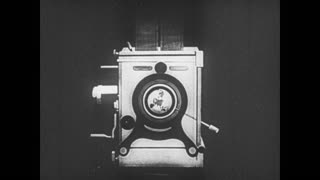This silent German Degeto Weltspiegel newsreel film was one of a series sold to German civilians in department stores and camera shops. It dates to 1942 but shows events in late 1941. It focuses primarily on the First Battle of Kiev. This was a major battle that resulted in an encirclement of Soviet troops in the vicinity of Kiev, the capital and most populous city of the Ukrainian Soviet Socialist Republic. This encirclement is the largest encirclement in the history of warfare by number of troops. The battle occurred from 7 July to 26 September 1941 as part of Operation Barbarossa, the Axis invasion of the Soviet Union. The battle was an unprecedented defeat for the Red Army. The encirclement trapped 452,700 Soviet soldiers, 2,642 guns and mortars, and 64 tanks, of which only 15,000 soldiers escaped from the encirclement by 2 October. It was the Wehrmacht’s greatest victory of the war.
The film begins with images of a passenger train hidden by dense foliage. It carries German military officials including Oberst Mölders (:29), Hermann Göring, Generaloberst Ernst Üdet, Major Oesau, and Oberst Adolf Galland. At (:57) a tactical map shows Mykolaiv Oblast, Ukraine, gateway to the Crimea. German troops on bicycles, motorcycles and halftracks move towards the objective while artillery strikes. At (1:22) a large pontoon bridge is shown. At (1:30), unfinished Russian warships are visible in the docks and, at (1:38) a train is visible in a floating dock. At (1:45), the city of Kherson is highlighted. Infantry move forward in a fog. At (2:14) the Germans use a Flammenwerfer 35, or FmW 35 (flame thrower) against Russian emplacements. At (2:22) the Germans cross the Dneiper. At (2:29) Dniepro is shown under attack, and a map (2:33) shows Kiev is next. Wheeled German armored cars, Panzer tanks and halftracks move on an angle from Korosten, Ukaine. Cavalry and artillery are shown advancing. At (3:24) the Desna River is crossed. At (3:37) a guard shack is blown up with a hand grenade. At (3:45) the map shows how the Germans outflanked the Red Army by advancing behind Kiev. At (3:50) motorcycles and tanks race to cut off the Russians, encircling them in Kiev. At (4:07) German Field Marshal Heinz Wilhelm Guderian is seen, followed by images of Russian troops surrendering en masse (4:21) as the pocket collapses. At (4:40) German troops walk across a smashed bridge. Fighting continues including an engagment at a bridge. The next objective (5:10) will be Odessa.
Adolf Josef Ferdinand Galland was a Luftwaffe general and flying ace who served throughout WWII. He flew 705 combat missions and fought on the Western Front and in the Defense of the Reich. On four occasions, he survived being shot down, and he was credited with 104 aerial victories, all of them against the Western Allies.
Werner Mölders was a Luftwaffe pilot, wing commander, and the leading German fighter ace in the Spanish Civil War. He became the first pilot in aviation history to shoot down 100 enemy aircraft and was highly decorated for his achievements. Mölders developed fighter tactics that led to the finger-four formation. He died in a plane crash as a passenger.
Walter “Gulle” Oesau was a fighter pilot during WWII. A fighter ace, he served in the Luftwaffe from 1934 until his death in 1944. He rose to command Jagdgeschwader 1, which was named in his honor after his death.
Ernst Udet was a German pilot during World War I and a Luftwaffe Colonel-General (Generaloberst) during World War II. The launch of Operation Barbarossa on 22 June 1941, combined with issues with the Luftwaffe’s needs for equipment outstripping Germany’s production capacity and increasingly poor relations with the Nazi Party, caused Udet to choose suicide on 17 November 1941 by shooting himself in the head.
Motion picture films don’t last forever; many have already been lost or destroyed. For almost two decades, we’ve worked to collect, scan and preserve the world as it was captured on 35mm, 16mm and 8mm movies — including home movies, industrial films, and other non-fiction. If you have endangered films you’d like to have scanned, or wish to donate celluloid to Periscope Film so that we can share them with the world, we’d love to hear from you. Contact us via the weblink below.
This film is part of the Periscope Film LLC archive, one of the largest historic military, transportation, and aviation stock footage collections in the USA. Entirely film backed, this material is available for licensing in 24p HD, 2k and 4k. For more information visit http://www.PeriscopeFilm.com


